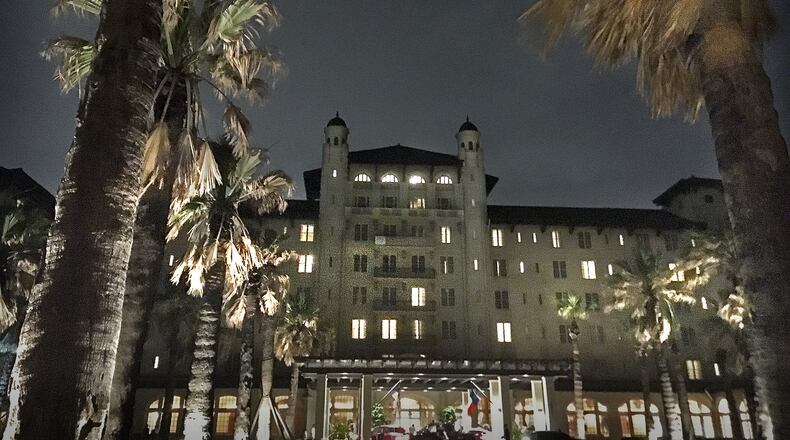The evening began innocently enough.
After arriving in Galveston, Texas, my travel companion and I were sipping gin gimlets at dusk inside the Hotel Galvez, a turn-of-the-century beauty built on the Gulf of Mexico’s edge. The grand hall — the pinnacle of the island city’s glamorous old architecture — buzzed with imbibers clinking glasses, chattering among tall limestone columns, arched windows and intricate tiled floors.
A stop in Galveston seemed the perfect finale to our weeks-long road trip across Texas.
But our weekend took a surprising turn when I left the table in search of a restroom.
I descended a stairwell, entered a dimly lit corridor and was met by one of the eeriest feelings of my life. I felt followed — then surrounded.
Sure someone was on my heels, I whirled around, fists clenched, only to stare into thin air.
The feeling chased me until I returned to the grand hall, hurriedly. That’s when I remembered “Ghosts of Galveston,” a book I had eyed in a boutique earlier in the day.
“Are there really ghosts in this town?” I asked our waitress.
She lifted an eyebrow.
“Oh, yes,” she replied. “Everywhere.”
What followed, over icy libations, was a tidal wave of spookiness: She told tales of glasses spontaneously broken, toilet paper rolls spinning uncontrollably and faces in the corners of empty rooms.
Hotel Galvez debuted in 1911 as the town was being rebuilt from the devastating 1900 hurricane that killed thousands. A candy and toy store that once sat on the Galvez site was destroyed. In the basement, near the restroom, our waitress told us, hotel guests and workers have often heard kids playing ball and laughing — or felt the curious young spirits trailing them.
I gulped. But there was more.
In the 1950s, a hotel guest hanged herself in her room after believing her lover had been lost at sea. Tragically, two days later, he returned.
Then there were the photos on the waitress’ phone. A face pressed against a shower curtain. A man in the mirror. A shadowy figure, captured by a 9-year-old.
“Well,” I said, “I’m glad we’re not staying here.”
Back at our hotel, the Tremont House — another historic relic — we grabbed waters to take upstairs and told the lobby bartender of our enlightenment that the Hotel Galvez, Tremont’s sister hotel, was severely haunted.
“Well, yeah,” she said blankly. “The whole town is.”
“But not here, right?” I offered.
“Yes,” she said. “Here, too.”
She explained, to our dread. Unlike the Hotel Galvez, Tremont House isn’t known as a haunted destination, but three ghosts allegedly wander the premises regularly, including a former Civil War soldier who supposedly drank himself to death and a little boy named Jimmy, who was killed by a car while playing outside. The tall palm trees that fill the enclosed courtyard sway excessively when the ghosts come and go, she said.
Specific rooms — on our floor, incidentally — get the bulk of the action. Doors opening and slamming on their own. Hair dryers unplugged but suddenly blowing air.
“They won’t hurt you,” she said, as we blinked.
We realized, then, that this cute and quirky city we’d joked was a ghost town during this off-peak time of year (we visited in May) was actually a town full of ghosts.
SLEEPLESS NIGHTS
That night, I barely slept, staring into the crevices of the dark room, then pinching my eyes shut, afraid of seeing something I’d be unable to forget.
The hotel’s old bones didn’t do much to ease my mind.
Although renovated with marble-topped vanities, tall ceilings and glistening wooden floors, the walls of the Tremont House still creak. Whenever we shut the bathroom door, an anxious, perpetual shuddering would ensue.
But when clearheaded morning logic set in the next day, we started to wonder if it was all a grand scheme — the hotel industry seizing on folklore and perpetuating it.
Galveston’s heyday began in the late 1800s, when it was one of the richest cities in America. After the 1900 hurricane, the city charged back into prominence in unlikely fashion: under the three-decade-long mob leadership of the legendary Maceo brothers, who later played a major role in developing the Las Vegas Strip. The “free state of Galveston” had been Las Vegas-like before the actual Vegas had ever come to be.
Since those so-called glory days, though, Galveston had endured more hurricane damage and the weathering of time. A dated city under the shadow of oil rigs just didn’t have the same draw it once did. Perhaps all of this ghost talk was part of an impressive new tourism campaign?
During breakfast at the counter of an off-the-beaten path nook called Sonny’s Place, we asked the 89-year-old proprietor if he had any ghost stories.
“No,” he said, “no ghosts,” dismissing the topic quickly.
Along the Strand, the name given to the town’s historic core, we talked to everyone we met, from the Old Strand Emporium, a general store featuring an ice cream shop, to La King’s Confectionery, a candy shop with wooden floors and exposed brick walls. In a contemporary section of town, we looked for clues in clothing boutiques and hipster coffee shops.
After lunch — a feast of crawfish and whole crabs at Benno’s on the Beach — we checked out a handful of antique shops and chatted with the cashiers. One chuckled at our unearthly query.
“There’s been a lot of talk about that,” she said. “But I haven’t seen anything.”
About the Author
Keep Reading
The Latest
Featured


